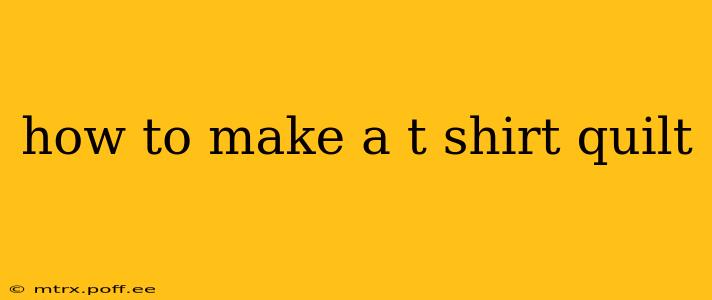Creating a t-shirt quilt is a fantastic way to transform cherished memories into a cozy and unique keepsake. Whether you're commemorating a special event, celebrating a milestone, or simply preserving favorite shirts, this guide will walk you through the process step-by-step. We'll cover everything from selecting your shirts to the final quilting, ensuring you create a quilt you'll treasure for years to come.
Choosing Your T-Shirts and Planning Your Design
Before you dive into the sewing, careful planning is key. The first step is selecting your t-shirts. Consider the following:
- Number of shirts: How large do you want your quilt to be? A larger quilt requires more shirts. A typical throw size requires 12-18 shirts.
- Shirt sizes and colors: A mix of sizes and colors can add visual interest, but too much variety can make the quilting process more challenging. Consider a color scheme or theme to help with organization.
- Shirt condition: Ensure your shirts are clean and in good condition. Avoid using heavily faded or damaged shirts.
Preparing Your T-Shirt Squares: Cutting and Stabilizing
This step is crucial for a professional-looking quilt. Improper preparation can lead to stretched or distorted squares.
- Wash and dry your shirts: This pre-shrinks the fabric, preventing future shrinkage that could ruin your quilt.
- Cut your squares: Use a rotary cutter and mat for accurate cuts. Standard sizes are 12"x12", but you can use other sizes depending on your desired quilt size. Always cut with the grain of the fabric for stability. A good tip is to plan your layouts before cutting, so you have some idea of the finished size.
- Stabilize your squares: This is arguably the most important step. T-shirt fabric is stretchy, and stabilization prevents distortion during the quilting process. Iron-on interfacing is a popular choice, offering support and preventing the squares from stretching. Follow the manufacturer's instructions carefully.
Arranging and Sewing Your T-Shirt Blocks
Once your squares are prepared, it's time to arrange them into a pleasing design.
- Layout options: You can arrange your shirts randomly, chronologically (by date of event), or by color theme. Consider using a large floor space to lay out your blocks before sewing.
- Sewing blocks together: After arranging the blocks, sew them together using a 1/4 inch seam allowance. Accuracy is important here to ensure your quilt blocks align correctly. Press seams flat as you go.
Adding a Backing and Binding
With your quilt top complete, you need to add a backing and binding to create a finished quilt.
- Choosing backing fabric: Select a fabric that complements your t-shirt squares. Cotton or flannel are popular choices.
- Sewing the backing: Lay the backing fabric right-side down and place your quilt top on top. Sew together with a 1/4 inch seam.
- Adding the binding: Cut and sew your binding fabric. This creates the finished edge of your quilt and provides durability.
Quilting Your T-Shirt Quilt: Techniques and Considerations
Quilting adds strength and structure to your quilt. The type of quilting you choose depends on your skill level and desired aesthetic.
- Simple straight-line quilting: This is a beginner-friendly option. Use a walking foot on your sewing machine to ensure even stitching.
- More intricate designs: If you're more experienced, you can try free-motion quilting or other decorative stitching techniques.
- Quilting density: Consider the quilting density—more quilting means a more durable quilt, but it also takes longer.
Finishing Touches: Pressing and Enjoying Your Creation
The final step involves pressing your quilt and adding any final touches.
- Pressing your quilt: Press your quilt to remove any wrinkles and ensure a smooth finish.
- Adding labels: Consider adding a label with the year, names, or a special message.
Frequently Asked Questions
What type of fabric is best for backing a t-shirt quilt?
Cotton or flannel are excellent choices for backing fabric. They offer a soft feel and good durability.
How do I prevent my t-shirt quilt from stretching?
Using iron-on interfacing to stabilize each t-shirt square before sewing is crucial to prevent stretching.
What is the best way to quilt a t-shirt quilt?
Simple straight-line quilting is a beginner-friendly and effective method. More experienced quilters can explore more intricate designs.
Can I machine wash a t-shirt quilt?
Yes, but always check the care instructions for your backing and binding fabrics. It's generally recommended to wash it on a gentle cycle in cold water and tumble dry on low heat.
Creating a t-shirt quilt is a rewarding project that allows you to preserve cherished memories. By following these steps and taking your time, you can craft a beautiful and lasting treasure. Remember to enjoy the process!
